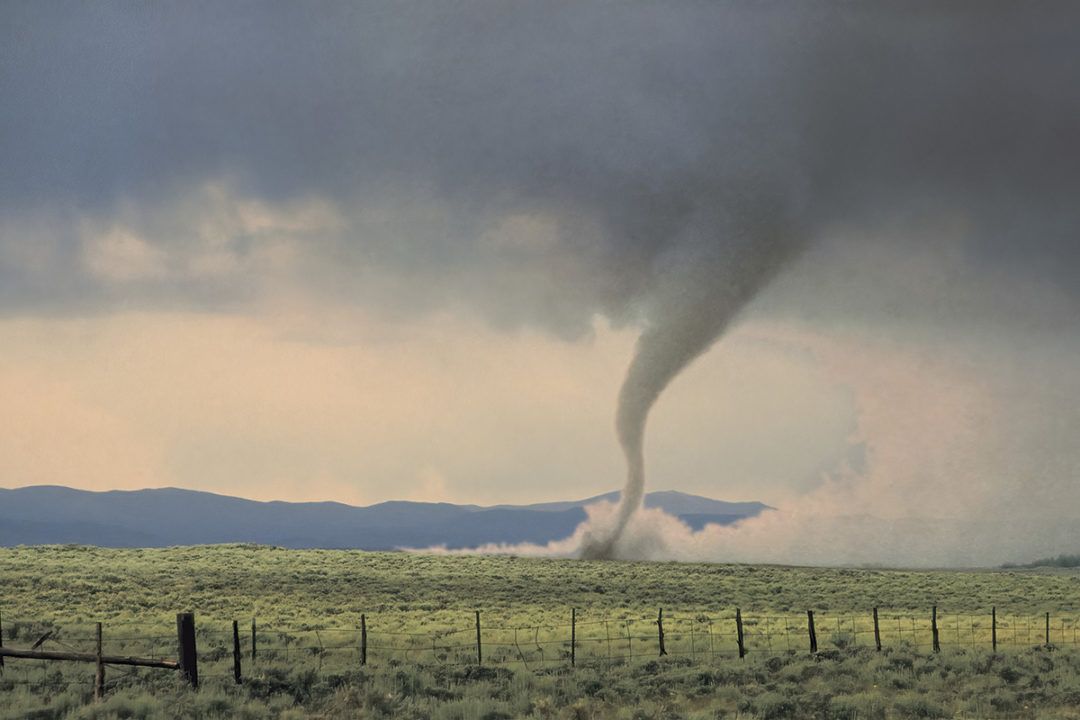The exact location and intensity of summer thunderstorms is somewhat unpredictable. Don’t allow the frequency of storm watches lull you into complacency. Severe weather – such as a tornado – can form quickly and turn deadly in just moments.
Whenever thunderstorms are possible in your location, keep an eye to the sky and monitor weather updates on your phone’s weather app. If the sky begins looking dark, it’s likely that thunderstorms are developing.
One of the most dangerous elements of a severe thunderstorm is the potential for a tornado, which can form with little advance warning. A tornado may form so quickly the weather service isn’t able to get a tornado warning out before it strikes.
According to the National Oceanic and Atmospheric Administration (NOAA), tornadoes are one of nature’s most violent storms. In an average year, about 1,000 tornadoes are reported across the U.S., resulting in 80 deaths and more than 1,500 injuries.
A tornado is a violently rotating column of air that extends from a thunderstorm to the ground. Tornado wind speeds can reach as much as 250-plus mph and damage paths can be in excess of 1 mile wide and 50 miles long.
Tornadoes can strike at any time of the day or night and any time of year. Tornadoes are most common in the central Plains and southeastern U.S. However, tornadoes have been reported in all 50 states.
Protect yourself
The most effective means of protecting oneself from a tornado is being alert to the potential for it to strike and knowing how to find appropriate shelter. Information regarding potential for severe storms and/or tornadoes is available through local news, a NOAA weather radio or alerts on weather app.
If your community sends warnings, sign up to receive them. Some communities have outdoor sirens. Others may rely on media and smartphones to send out storm alerts.
Farm families and agricultural employees should create a communications plan that includes an emergency meeting place. More details about creating an emergency plan can be found at Ready.gov
When working out in an open area – field, cattle yard, etc. – know where the closest storm shelter is located and give yourself time to reach it before a tornado strikes. Some tornadoes may travel at speeds up to 70 mph.
Dangerous lightning
Lightning trackers are available on smartphone weather apps. There is no safe place outside when thunderstorms are in the area. If you hear thunder, you’re likely within striking distance of the storm. Lightning can occur within a 10-mile radius of a severe storm.
The National Weather Service says too many people wait far too long to get to a safe place when thunderstorms approach. Unfortunately, these delayed actions lead to many of the lightning deaths and injuries in the U.S.
Appropriate shelter
When designating a storm shelter location, select a room such as a basement, storm cellar or interior room on the lowest floor of the building where there are no windows. If there is no basement, go to an inside room without windows. This could be a center hallway, bathroom or closet.
Avoid taking shelter where there are heavy objects on the floor directly above you. Items such as refrigerators or pianos could fall through the floor if a tornado strikes. Getting under something sturdy – a heavy table or workbench – will help protect you from flying debris. Protect your head with anything available – even your hands.
Once a plan is in place, conduct a drill on a regular basis so everyone knows how to respond to the threat of an approaching tornado. For either a family or work area, make sure everyone is informed about a tornado warning.
A watch or a warning?
Understanding the difference between a tornado watch and a warning is key to staying safe if a tornado strikes. When a watch is issued, know that tornadoes are possible in and near the watch area. Everyone working in an agricultural setting, whether working inside or outdoors, must be aware of emergency plans and be ready to act quickly if a warning is issued or there’s reason to suspect a tornado is approaching.
Sometimes, a tornado forms so quickly weather officials don’t have time to issue a warning. The signs that a tornado is approaching include:
- Seeing a rotating funnel-shaped cloud
- Approaching cloud of debris
- Dark or green-colored sky
- Large, dark, low-lying cloud
- Large hail
- Loud roar that sounds like a freight train
If a warning has been issued, there is imminent danger to life and property in the warning area. Everyone in the vicinity should take shelter in an interior room of the lowest floor of a sturdy building.
A vehicle is not a safe shelter during a tornado. The best course of action is to drive to the closest shelter. However, never try to outrun a tornado. If reaching safe shelter isn’t possible, get down inside the car and cover your head, or abandon the vehicle and seek shelter in a low-lying area such as a ditch, culvert or ravine.
When tornadoes strike
If a tornado strikes, follow the emergency response plan and get to a safe building. Continue to listen to local news or a NOAA weather radio to stay updated about tornado watches and warnings because multiple rounds of thunderstorms capable of producing tornadoes are possible during severe weather outbreaks.
Following the emergency response communication plan, let everyone know you are safe and unharmed. When walking through storm damage, wear long pants, a long-sleeved shirt and sturdy shoes.
Once the threat of tornadoes is over, assess the damage. Be aware that live power lines may be in the vicinity. If so, completely avoid them and contact local authorities.
If anyone is injured, provide first aid to victims until emergency response teams arrive.
The peak tornado season for the northern Plains and Upper Midwest is June and July. But tornadoes can happen at any time of the year. They can happen at any time of day or night, but most tornadoes occur between 4 p.m. and 9 p.m. Never assume it can’t happen where you are.
Find more severe weather details at NOAA’s “Severe Weather 101.”









